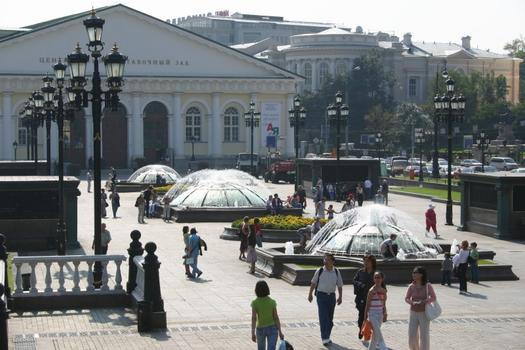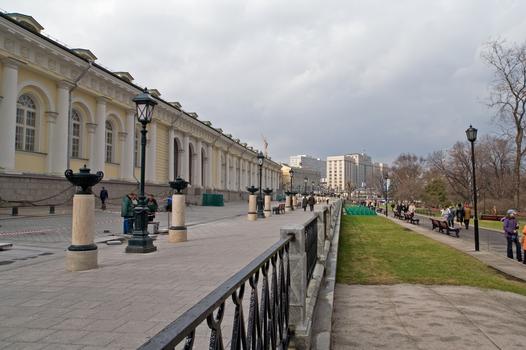General Information
| Name in local language: | Манеж |
|---|---|
| Other name(s): | Манеж |
| Beginning of works: | 1817 |
| Completion: | 1825 |
| Status: | in use |
Project Type
| Function / usage: |
original use: Riding hall later use: Museum building |
|---|---|
| Architectural style: |
Neoclassical |
Location
| Location: |
Moscow, Central Federal District, Russia |
|---|---|
| Coordinates: | 55° 45' 12" N 37° 36' 44" E |
Technical Information
Dimensions
| length | 166 m | |
| roof | span | 45 m |
Materials
| beams |
wood
|
|---|
Chronology
| 14 March 2004 | The hall is destroyed in a fire. |
|---|---|
| 18 February 2005 | The restored building is reopened with the same exhibit that was due to open on the day of the fire. |
Excerpt from Wikipedia
The Moscow Manege (Russian: Мане́ж, IPA: [mɐˈnʲeʂ] (listen)) is an oblong building which gives its name to the Manege Square, which was cleared in the 1930s and lies adjacent to Red Square. It is the site of Moscow Design Museum since 2012.
Designed by Spanish engineer Agustín de Betancourt with a roof without internal support for 45 metres (148 ft) (the building's width), it was erected from 1817 to 1825 by the Russian architect Joseph Bové, who clothed it in its Neoclassical exterior, an order of Roman Doric columns enclosing bays of arch-headed windows in a blind arcade, painted white and cream yellow. The roof, with its internal rafters and beams exposed, rests on external columns of the Manege.
The structure was used first as a traditional manège, an indoor riding academy, to house parades of horsemen and a training school for officers. The 180 m long Manege was large enough to hold an entire infantry regiment—over two thousand soldiers— as well as an invited audience. Since 1831 it has been an exhibition place. In 1867, Hector Berlioz and Nikolai Rubinstein performed at the Manege before a crowd of 12,000. During the Soviet years, the building was used as an art gallery. It was there that Nikita Khrushchev chided avant-garde artists for promoting degenerate art, an episode known as the Manege Affair.
On 14 March 2004, the night of a Russian Presidential election in which Vladimir Putin was overwhelmingly re-elected for a second four-year term, the building caught fire and burnt down, killing two firefighters. The wooden beams and rafters collapsed, leaving the walls remaining on site. The official investigation concluded that a short-circuit caused the fire, though there was media speculation that a fire at such a historic building, only a stone's throw from the Kremlin, on the night of a Presidential election, may not have been coincidental. On 18 February 2005 the restored Manege resumed ist operation as an exhibition hall by mounting the same exposition that had been scheduled for the day of the fire.
Text imported from Wikipedia article "Moscow Manege" and modified on 23 July 2019 under the CC-BY-SA 3.0 license.
Participants
- Osip Ivanovich Bove (Joseph Bové) (architect)
- Agustín de Bétancourt y Molina (engineer)
Relevant Web Sites
Relevant Publications
- (1997): L'architecture et les ingénieurs. Deux siècles de réalisations. Moniteur, Paris (France), pp. 280.
- (2004): Destruido por el fuego el Picadero de Moscú. In: Revista de Obras Públicas, v. 151, n. 3443 (April 2004), pp. 59-61.
- About this
data sheet - Structure-ID
20012145 - Published on:
21/05/2004 - Last updated on:
24/06/2022








